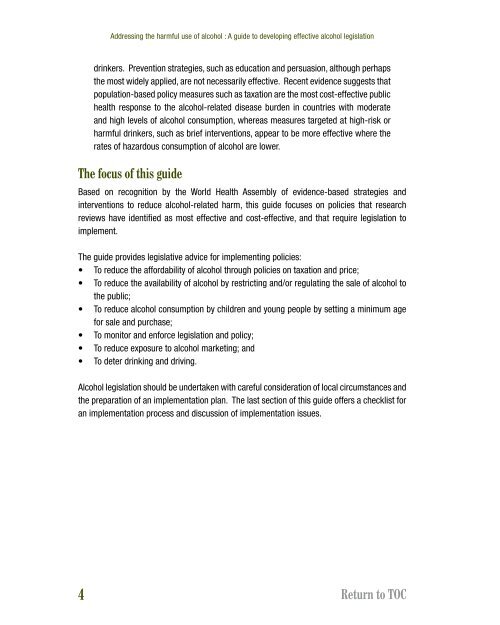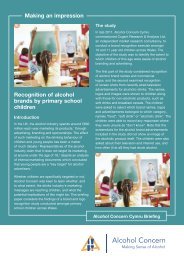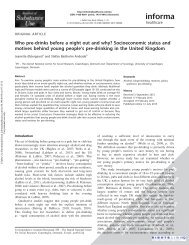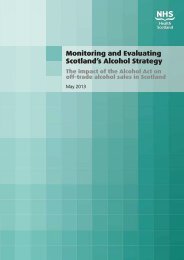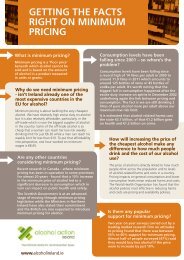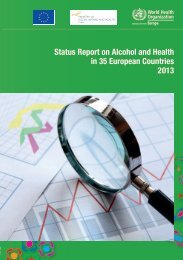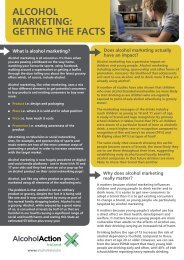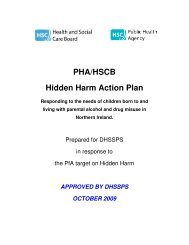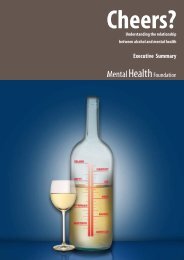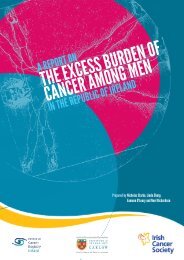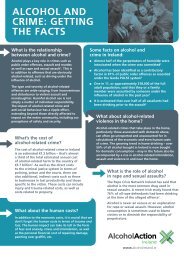Addressing the harmful use of alcohol - WHO Western Pacific Region
Addressing the harmful use of alcohol - WHO Western Pacific Region
Addressing the harmful use of alcohol - WHO Western Pacific Region
Create successful ePaper yourself
Turn your PDF publications into a flip-book with our unique Google optimized e-Paper software.
<strong>Addressing</strong> <strong>the</strong> <strong>harmful</strong> <strong>use</strong> <strong>of</strong> <strong>alcohol</strong> : A guide to developing effective <strong>alcohol</strong> legislation<br />
drinkers. Prevention strategies, such as education and persuasion, although perhaps<br />
<strong>the</strong> most widely applied, are not necessarily effective. Recent evidence suggests that<br />
population-based policy measures such as taxation are <strong>the</strong> most cost-effective public<br />
health response to <strong>the</strong> <strong>alcohol</strong>-related disease burden in countries with moderate<br />
and high levels <strong>of</strong> <strong>alcohol</strong> consumption, whereas measures targeted at high-risk or<br />
<strong>harmful</strong> drinkers, such as brief interventions, appear to be more effective where <strong>the</strong><br />
rates <strong>of</strong> hazardous consumption <strong>of</strong> <strong>alcohol</strong> are lower.<br />
The focus <strong>of</strong> this guide<br />
Based on recognition by <strong>the</strong> World Health Assembly <strong>of</strong> evidence-based strategies and<br />
interventions to reduce <strong>alcohol</strong>-related harm, this guide foc<strong>use</strong>s on policies that research<br />
reviews have identified as most effective and cost-effective, and that require legislation to<br />
implement.<br />
The guide provides legislative advice for implementing policies:<br />
• To reduce <strong>the</strong> affordability <strong>of</strong> <strong>alcohol</strong> through policies on taxation and price;<br />
• To reduce <strong>the</strong> availability <strong>of</strong> <strong>alcohol</strong> by restricting and/or regulating <strong>the</strong> sale <strong>of</strong> <strong>alcohol</strong> to<br />
<strong>the</strong> public;<br />
• To reduce <strong>alcohol</strong> consumption by children and young people by setting a minimum age<br />
for sale and purchase;<br />
• To monitor and enforce legislation and policy;<br />
• To reduce exposure to <strong>alcohol</strong> marketing; and<br />
• To deter drinking and driving.<br />
Alcohol legislation should be undertaken with careful consideration <strong>of</strong> local circumstances and<br />
<strong>the</strong> preparation <strong>of</strong> an implementation plan. The last section <strong>of</strong> this guide <strong>of</strong>fers a checklist for<br />
an implementation process and discussion <strong>of</strong> implementation issues.<br />
4 Return to TOC


